В.Кондратьев Самолеты первой мировой войны
МОДИФИКАЦИИ
VGO-III и "Цеппелин-Штаакен" R-IV. Силовая установка этих машин состояла из шести двигателей в трех спарках. В каждой мотогондоле VGO-III стояли по два 160-сильных "Мерседеса" D.III на одном валу, а в носовой части фюзеляжа - два таких мотора, установленные бок о бок с общим редуктором. На R-IV таким же образом были смонтированы шесть 220-сильных двигателей "Бенц" Bz.IV. Вооружение - 4-5 пулеметов: 2 в носовых законцовках гондол и 2-3 в фюзеляжных люковых установках за крылом. Бомбовая нагрузка - до 1000 кг. Экипаж - 7-8 человек. В 1916-1917 годах VGO-III и R-IV применялись на русско-германском фронте, в Прибалтике. Летом 1917-го R-IV переведен на западный фронт и до весны следующего года участвовал в налетах на Лондон.
Четырехлопастные винты на R-V приводились в движение пятью моторами "Майбах" Mb.IV по 240 л.с. (1 в носу и 2 спарки в гондолах). В фюзеляже R-VII стояли 2 "Мерседеса" по 160 л.с., а в гондолах - 4 "Бенца" по 220 л.с. Обе машины в 1917 году отправили на западный фронт. R-VII разбился по дороге, а R-V некоторое время использовался в качестве ночного бомбардировщика.
O.Thetford, P.Gray German Aircraft of the First World War (Putnam)
Zeppelin-Staaken V.G.O. III
Due to the V.G.O. I and II not being powerful enough, the V.G.O. III was powered with six engines; two mounted side-by-side in the nose and two in each nacelle mounted tandem fashion driving a single pusher airscrew. Serialled R 10/15, the machine was sometimes known as R III and used by Rfa 500 on the Eastern Front. Engines, six 160 h.p. Mercedes D III. Span, 42.2 m. (138 ft. 5 5/8 in.). Length, 24.5 m. (80 ft. 4 3/4 in.). Height, 6.8 m. (22 ft. 3 3/4 in.). Area, 332 sq.m. (3,586 sq.ft.). Weights: Empty, 8,600 kg. (18,920 lb.). Loaded, 11,600 kg. (25,520 lb). Speed, 120 km.hr. (75 m.p.h.). Climb, 2,000 m. (6,560 ft.) in 29 min. Armament, five machine-guns.
Zeppelin-Staaken R IV
This machine was the first of the Staaken "Giants" to bear the official R designation. It was similar in most respects to the V.G.O. III, adhering to the same six-engined formula, but with the more powerful 220 h.p. Benz engines fitted in the nacelles, driving single four-bladed airscrews. Serialled R 12/15, this aircraft saw service on both Eastern and Western fronts. Engines, six - two 160 h.p. Mercedes D III in nose, four 220 h.p. Benz Bz IV in nacelles. Span, 42.2 m. (138 ft. 5 5/8 in.). Length, 23.2 m. (76 ft. 1 1/2 in.). Height, 6.8 m. (22 ft. 3 3/4 in.). Area, 332 sq.m. (3,586 sq.ft.). Weights: Empty, 8,772 kg. (19,298 lb.). Loaded, 13,035 kg. (28,677 lb.). Speed, 125 km.hr. (78.125 m.p.h.). Climb, 3,000 m. (9,840 ft.) in 89 min. Duration, 6-7 hr. Armament, six or seven machine-guns.
0 min. Armament, five machine-guns.
Zeppelin-Staaken R VII
The R VII was a development of the R IV, and differed very little visibly from that machine. The same engine arrangement was adhered to, but there was some alteration in the system of bracing struts between the tailplanes. Serialled R 14/15, the R VII crashed while on a delivery flight to the Front. Engines, two 160 h.p. Mercedes D III in nose, four 220 h.p. Benz Bz IV in nacelles. Span, 42.2 m. (138 ft. 5 5/8 in.). Length, 22.1 m. (72 ft. 6 1/4 in.). Height, 6.8 m. (22 ft. 3 3/4 in.). Area, 332 sq.m. (3,586 sq.ft.). Weights: Empty, 8,923 kg. (19,741 lb.). Loaded, 12.953 kg. (28,497 lb.). Speed, 130 km.hr. (81.25 m.p.h.). Climb, 3,000 m. (9,840 ft.) in 50 min. Armament, five machine-guns.
G.Haddow, P.Grosz The German Giants (Putnam)
VGO.III
During October 1915 construction of the third Staaken giant, the VGO.III, was begun at Gotha. Early in the design stage it was decided to find alternative engines for the experimental 240 h.p. Maybach HS engines, which had proven to be unreliable for extended flights. In their place, the thoroughly-tested 160 h.p. Mercedes D.III engine was chosen, and to compensate for their lower output, six engines were used, increasing the total horse-power of the VGO.III to 960 h.p. as compared to the 720 h.p. available to the first two VGO types.
The method of installation was entirely new. Two engines were mounted side by side in the fuselage nose and their crankshafts faced a central gear-box at an angle of about 8 degrees. Two large clutches were fitted to the front of each engine. A short extension shaft coupled each engine to the gear-box, which in turn drove a large tractor propeller. This method of coupling two engines to a common gear-box proved fairly successful as long as the engine crews were well trained and low-powered engines were used. Even so, this system was not entirely free of faults. The drive assembly produced a great deal of noise, particularly at certain engine speeds when fuselage, gears, extension shaft and propellers all began to resonate in unison. In fact, it was possible to see the standing waves in the extension shaft change as the engine speed was varied. In one instance the extension shaft broke in flight, and it required some four to six weeks to repair the damage. Later attempts to couple higher-powered engines to a common gear-box proved generally unsuccessful (see VGO.I and Staaken R.VII). Two large block radiators were mounted above the nose directly behind the propeller. The engines could be serviced in flight by a mechanic stationed in the large engine compartment, but from all accounts the ear-splitting noise made his life virtually impossible. Access was provided by a door on the port side, through which other crew members could also enter. The compartment was fitted with windows and sliding hatches to adjust interior ventilation, as well as a large open cockpit for the engine crew.
The remaining engines were mounted in tandem pairs in the outboard nacelles and drove pusher propellers. The leading engine was mounted lower in the nacelle, allowing a transmission shaft to pass under the rear engine; both drive shafts terminated in a common gear-box. The individual clutches allowed the engines to be started singly and run independently of each other. The nacelles were lengthened considerably to accommodate the additional length of the engine-gear-box combination. To support the overhanging weight of these components an extra pair of struts was added at the rear of the nacelle. A pair of block radiators were mounted side by side between the nacelle and upper wing just behind the forward struts.
As in the VGO.II, the nacelle engines were serviced by a gunner-mechanic who occupied the gun position in the front of each nacelle. Other machine-guns were located in dorsal and ventral fuselage positions behind the wings. Several tests were performed to investigate the feasibility of firing a 2 cm. cannon from the dorsal gun position; however, machine-guns remained the standard armament.
The wing was identical to those used on the earlier machines, with the addition of a long gravity tank fitted at the junction of the centre-section struts. During flight testing an unusual system of aileron balance was tested. Small auxiliary surfaces were hinged two-thirds up the rear outer interplane strut. About three-quarters of this surface was in front of its hinge point. This experimental aileron compensator was connected to the main aileron cables in such a way that it would aerodynamically lighten the loads on the control cables. Although this primitive method of aileron "balancing" was used on a number of contemporary Gotha and Brandenburg seaplanes, it did not find favour on the VGO.III, as it was later removed and not used again on other Staaken machines.
Aside from the addition of the flight-engineer's compartment in the nose and the relocation of the pilot's cockpit farther aft, the VGO.III fuselage was similar to the VGO.II. All tail control cables were housed internally, emerging from the fuselage about 6 feet from the tail. This became a standard practice on all future Staaken R-planes. The tail unit was similar to the VGO.II, with the exception of slightly increased fin area.
The aircraft was allocated serial number R.10/15. The exact date of the first flight is unknown, but it occurred between 29 May and 4 June 1916. On 13 June 1916 it flew from Gotha to Friedrichshafen (to have the Zahnradfabrik G.m.b.H. run tests with the propeller reduction gearing) landing at Sindel fingen (location of the Daimler airfield) on the way. The VGO.III was accepted by Idflieg (Rea) on 28 August 1916 and delivered to Rfa 500 on 8 September. Offstv. Selmer, who also piloted the VGO.III, stated that the bomb installation was improved over earlier types, in that the bombs were hung beside each other rather than over one another and were released electrically. The crew consisted of seven men, including one wireless operator who worked the only type of wireless set fitted to R-planes at the time: a Siemens-Schuckert transmitter initially built for Austrian bombing planes and a Telefunken receiver. Power was supplied by an AEG generator driven by a small 2-cylinder Bosch petrol engine. Attempts to drive the generator by coupling it directly to the engines or by a small slipstream-mounted propeller were unsuccessful.
The VGO.III completed about seven bombing missions, during which it targets were railway installations, troop encampments and depots in the vicinity of Riga. On a 3 hr. 10 min. bombing mission on 22 September 1916, it carried a useful load of 3310 kg. and reached an altitude of 3000 metres.
On 24 January 1917 the first fatal R-plane accident occurred when the VGO.III, returning from a training mission, came in to land at Alt-Auz. With Selmer at the controls, the VGO.III was forced to touch-down prematurely due to a sudden downdraft. The ground was soft and covered with snow, and after some 10 metres the front wheels struck a hidden obstruction and snapped off. The sudden braking action caused the main undercarriage to collapse, the fuselage to break in two and the lower wings to tear off. The ruptured fuel lines sprayed petrol over the nose exhaust stacks, and the VGO.III was completely destroyed by fire, with loss of five crew members. A survivor stated that the forward fuel tank had burst on impact and had filled the fuselage with petrol. At an inquiry into the causes of the accident it was concluded that the nose undercarriage struts were too robust. Had they broken away sooner on striking the obstruction, the crash might not have been so serious. On later Staaken types the nose undercarriage or "Srossfahrgesrell" was considerably shortened and possibly reduced in strength.
Colour Scheme and Markings
The VGO.III was clear doped overall, giving it a cream-buff colour. The cross Patee on white squares was carried on the fuselage sides and on all four wingtips. The outer fin and rudder surfaces were painted all white, and the cross Patee was the largest posible for the area available. No other markings were visible.
SPECIFICATIONS
Type: VGO.III
Manufacturer: Versuchsbau G.m.b.H., Gotha-Ost
Engines: Six 160 h.p. Mercedes D.III engines
Dimensions:
Span, 42•2 m. (138 ft. 5 1/2 in.)
Length, 24•5 m. (80 ft. 4 1/2 in.)
Height, 6•8 m. (22 ft. 3 1/2 in.)
Areas: Wings, 332 sq. m. (3572 sq. ft.)
Weights:
Empty, 8600 kg. (18,963 lb.)
Loaded, 11,600 kg. (25,578 lb.)
Bomb load, 400-800 kg. (882-1764 lb.)
Performance:
Maximum speed, 120 km.h. (75 m.p.h.)
Climb,
1000 m. (3281 ft.) in 16 mins.
2000 m. (6562 ft.) in 29 min.
3000 m. (9843 ft.) in 56 mins.
Ceiling, 3000 m. (9843 ft.)
Duration, 6 hours
Fuel: 3500 litres (770 Imp. Gals.)
Armament: Provision for two dorsal, one ventral and two nacelle machine-gun positions
Service Use: Eastern Front with Rfa 500 at Alt-Auz, September 1916-January 1917
Staaken R.IV
With the growth of Allied air power, the possibility of an air strike against the Zeppelin airship works at Manzell became increasingly threatening. To forestall a possible crippling blow to the German airship programme, Major Thomsen urged the Zeppelin concern to establish a subsidiary airship works in a safer location, which it did in early 1916 at Staaken near Berlin. On 1 August 1916 the VGO works was officially transferred from Gotha to Staaken and renamed Flugzeugwerft G.m.b.H. The move was a natural outcome of the growth of the industry. Staaken would offer better facilities for the expansion of Zeppelin R-plane production and release space for Gotha Waggonfabrik. On 15 June 1916, the first group of VGO personnel began the transfer to Berlin (Staaken). With the reduction of airship construction in 1917 and its stoppage in January 1918, the Flugzeugwerft G.m.b.H. was easily able to absorb the airship workers and hangar space.
A contemporary report states that the fourth VGO R-plane was in its first stages of construction at Gotha in February 1916. The machine completed its maiden flight on 16 August 1916, and by the time it had finished its flight tests the transfer of VGO to Staaken had taken place. Consequently, on being delivered to the Army this machine was the first of the Zeppelin-built giants to be officially designated a Staaken type, and under the Idflieg numbering system was known as the Staaken R.IV 12/15.
The general layout of the Staaken R.IV followed closely that of its predecessor, the VGO.III. There was no change in the installation of the two 160 h.p. Mercedes D.III engines in the nose. The only visible differences were the close spacing of the two radiators and the exhaust stacks fitted into channels in the upper fuselage panelling. This in contrast to the VGO.III, where the stacks were housed internally and emerged at a sharp angle from the side panels.
The desirability for more power and the availability of the new 220 h.p. Benz Bz.IV engines led to their installation as tandem pusher units in the nacelles. The additional 240 h.p. over the VGO.III gave the Staaken R.IVa total of 1200 h.p. and made it the first of the more powerful second generation Staaken R-planes. The engine coupling in the R.IV proved very successful, primarily for the reason that exceedingly well-trained engine crews had been assigned to this machine, making a thorough test programme possible. In fact, the R.IV was the only R-plane with coupled engines to see service on both the Eastern and Western fronts up to the very end of the war. A remarkable showing, considering the difficulties experienced by other Staaken R-planes fitted with coupled engines.
The nacelle engines were arranged in the same way as in the VGO.III, but it was necessary once again to lengthen the nacelles to accommodate the new gear-box, Mercedes-built clutch and larger engines. Zahnradfabrik G.m.b.H., a Zeppelin subsidiary, built the gear-box, which reduced the 1400 r.p.m. of the engine to 860 r.p.m. for the propellers. The Garuda four-bladed propellers rotated in opposite directions and were placed well clear of the trailing edges. Initially the nacelle radiators were mounted in the manner of the VGO.III, but as these did not provide sufficient cooling, they were replaced by larger radiators mounted on front and rear nacelle struts; the front radiator was higher than the rear to avoid blanketing the rear radiator.
The same wing structure was employed, differing only in the reduction of lower wing dihedral from 3 to 1 1/2 degrees.
The fuselage was shortened slightly ahead of the wings; the open engineer's cockpit was replaced by a square hatch with sliding covers and the ventral machine-gun position was lowered to improve the field of fire. The resultant fairing produced a noticeable bulge under the fuselage.
Although the tail remained structurally the same, it was raised to a position above the fuselage to prevent damage to the tail surfaces when landing on the tail skid. The lower tail pars ran under the top fuselage longeron, a feature retained on succeeding type. With the exception of landing lights attached to the auxiliary struts, the design of the undercarriage remained unchanged.
A great deal of thought was given to the defensive armament of the R.IV. Soon after initial flight tests, machine-gun positions were built into the upper wings directly above the nacelles and behind the rear wing spar. Counting the two dorsal, one ventral and two forward nacelle gun positions, a formidable armament of seven machine-guns could be carried; a considerable number for one aircraft at that time. The wing position was reached by climbing a ladder leading from the nacelle to a platform hinged to the rear nacelle struts. The platform could be folded to allow the gunner to climb up and down, and sliding panel above and below the wing enclosed the position when not in use. The ladder was completely exposed and only a few feet from the propeller, so that the journey to the gun position must have been both exciting and hazardous. Idflieg considered the wing position useful, for they continued to be installed in several of the later Staaken types.
After flight tests and modifications were successfully completed the R.IV was accepted by the Army Air Services on 5 May 1917 to begin an operational service life longer than any other R-plane. On 12 June 1917, the R.IV was flown to Alt-Auz from Gotha via Doberitz and Konigsberg to join Rfa 500. The flight went smoothly in every respect. On the Eastern Front the R.IV participated in raids on Wolmar (28/29 June 1917), Oesel (8/9 July 1917) and possibly other Russian targets. A contemporary report describes the transfer of the R.IV to the Western Front.
On the flight from Alt-Auz to Metz the stages Alt-Auz-Konigsberg and Konigsberg-Doberitz were completed without mishap. The fact that both stages were flown at night, without specific orders to do so, is proof of the crew's confidence in the aircraft. The landing in Konigsberg on 18 July 1917, performed in ground fog, went smoothly.
Assigned to Rfa 501 stationed in the Ghent district, the R.IV listed London, Chelmsford, Thames Estuary, Calais, Morville, Boulogne, Etaple , le Havre, Gravelines, Deauville and Doullens as its targets in its long and varied career on the Western Front, during which a total of 25.000 kg. bombs were dropped. It also survived a collision with the balloon apron guarding London. After the war the R.IV, presumably en route to Liegnitz to be broken up, was, in April 1919, shown to awed crowds at Kassel and other German cities.
Colour Scheme and Markings
In its first form the R.IV was clear doped overall and carried national markings of the same style and pattern as the VGO.III. Later, with the installation of the wing gun positions, it was either re-covered in printed fabric with the standard irregular polygon design, or the design was painted over the old fabric. The Patee crosses were outlined in white on the camouflage pattern, but by mid-1918 these had been changed for the Latin cross with narrow white outlines. These crosses occupied the full chord of the wings, the depth of the fuselage side and the entire area of the fins and rudders.
SPECIFICATIONS
Type: Staaken R.IV
Manufacturer: Flugzeugwerft G.m.b.H., Staaken, Berlin
Engines:
Two 160 h.p. Mercedes D.III engines
Four 220 h.p. Benz Bz.IV engines
Dimensions:
Span, 42•2 m. (138 ft. 5 1/2 in.)
Chord inner, 4•6 m. (15 ft. 1 in.)
Chord outer, 3•6 m. (11 ft. 10 in.)
Incidence inner, 3 1/2 degrees
Incidence outer, 2 degrees
Dihedral upper, None
Dihedral lower, 1 1/2 degrees
Length, 23•2 m. (76 ft. 1 in.)
Height, 6•8 m. (22 ft. 3 1/2 in.)
Tail span, 9 m. (29 ft. 6 in.)
Wheel diameter, 1•02 m. (3 ft. 4 in.)
Tractor propeller diameter, 4•2 m. (13 ft. 9 in.)
Pusher propeller diameter, 4•3 m. (14 n. 1 in.)
Areas: Wings, 332 sq. m. (3572 sq. ft.)
Weights:
Wings, 2,350 kg.
Fuselage, 1,450 kg.
Tail unit, 400 kg.
Undercarriage, 900 kg.
Accessories, 123 kg.
Engines and transmission, 3,549 kg.
----
Empty, 8,772 kg. (19,342 lb.)
Fuel, 2,140 kg. (4,719 lb.)
Disposable load, 2,123 kg. (4,681 lb.)
----
Loaded, 13,035 kg. (28,742 lb.)
Wing Loading: 39•2 kg. sq. m. (8,0 lb. sq. ft.)
Performance:
Maximum speed, 125 km.h. (77'5 m.p.h.)
Climb,
1000 m. (3281 ft.) in 10 mins.
2000 m. (6562 ft.) in 35 mins.
3000 m. (9843 ft.) in 89 mins.
Ceiling, 3700 m. (12,139 ft.)
Duration, 6-7 hrs.
Fuel:
2080 litres (458 Imp. Gals.)
Oil engines, 53 litres (11,7 Imp. Gals.)
Oil tank, 130 litres (28'6 Imp. Gals.
Armament: Provision for six to seven machine-gun positions.
Service Use: Eastern Front with Rfa 500 at Alt-Auz, June 1917 to July 1917. Western Front with Rfa 501 in Ghent area July 1917 to November 1918.
Staaken R.VII
The Staaken R.VII would appear on the imaginary Staaken family tree as a direct-line descendant of the earlier R.IV. There is little doubt that the R.VII was built to capitalize on the success experienced with the R.IV configuration. The R.VII employed the same engines and drive system, but differed very slightly from its predeces or in the following ways: upper-wing gun platforms were omitted; radiator positions were reversed; the engineer's compartment had open cockpits; the tail was a single-bay structure and the undercarriage mounted eight wheels. A more subtle but most important difference between the two aircraft was that the fuselage of the R.VII was about 4 feet shorter. The slim rear fuselage of earlier VGO-Staaken R-plane had tendency to bend and twist in flight; therefore, the length of the fuselage was reduced to increase its stiffness. All later Staaken aircraft had the shorter fuselage configuration for that reason.
The R.VII, serial number R.14/15, was accepted on 26 June 1917 after reaching an altitude of 3800 metres in 100 minutes carrying a useful load of 3600 kg. It was delivered to Idflieg (Rea) on 3 July and assigned to Rfa 501 on 29 July 1917 after successfully completing a 6 hr. 30 min. practice mission with military load the day before. Its service life was destined to be short, for it crashed in the following month. Here is what happened according to two eye-witness reports:
On Friday, 14 August 1917 the R.VII, commanded by officers of Rfa 500, was on its way to the Front. Although Rfa 500 did not arrive at Custinne until February 1918, it is believed that advance elements of Rfa 500 may have been sent to the Front sooner, possibly to join Rfa 501 in the Ghent area. It was decided to land on the airfield of Flieger Ersatzabteilung 5 (Fea 5) in Halberstadt for repairs, and an aircraft was immediately dispatched from Fea 5 to obtain replacement parts from Berlin. On Sunday, 19 August 1917 repairs were completed and the crew of nine climbed aboard to take-off before a crowd composed of city officials, off-duty soldiers and curious citizen. The R.VII headed into the wind down the airfield, at the far end of which was a low hill topped with a few tall pine trees. The Fea 5 target ranges were located on the far side of the hill, which dropped sharply into a rock-strewn ravine. At some 60-70 metres altitude the right wing seemed to drop, forcing the R.VII into a starboard turn, and it was apparent to the spectators that something was wrong with the aircraft. The facile Halberstadt trainers would have had no difficulty in swinging around to make a safe downwind landing, but the unwieldy R-plane was not capable of performing this manoeuvre quickly enough. To the anxious spectators it seemed as if the R.VII would either clear the pine and make an emergency landing in the treacherous terrain on the far side of the hill or attempt to drop into the pine trees on the hill. The port engines were throttled back and the R.VII lost altitude, seemingly in preparation to land in the trees. For the moment, it appeared as if the exertions of the crew were going to be crowned with success after all.
Suddenly, as if the starboard engines had jerked to a stop, the right wing lurched towards the ground and hooked a pine tree. With the added thrust of the port engines, the R.VII spin in a 180 degree arc, bounced off the hill and crashed into the ravine. The horrified spectator saw a black pall of smoke slowly rise into the air.
Three badly burned crew members managed to escape and the starboard nacelle mechanic, who saw the mishap coming, jumped free as the machine crashed. The wireless operator fought his way out of the flaming, twisted wreckage and a machine-gunner was pulled from the crash by an alert and brave non-commissioned officer. Six aircrew died in the crash.
What actually happened aboard the R.VII was told by the surviving flight mechanic. He stated that the replaced leather clutch facing had been cleared for flight by the aircraft's chief mechanic, who perished in the crash. Shortly after take-off the leather clutch burned through and the engine, robbed of its load and running at full speed, overheated and seized. Simultaneously, the other starboard engine, which was connected to the same gear-box, lost speed. The commander, noticing the difficulty, desperately signalled to the starboard mechanic, who interpreted the frantic hand waving a an order to shut off the engine. The surviving crew members felt the engines were cut just as the R.VII was turning back to the airfield. The starboard wing dropped, hooked the pine tree and the fate of the R.VII was sealed.
Colour Scheme and Markings
The R.VII had a buff finish reminiscent of the early VGO types and carried the Patee cross insignia with white edges on wings, fuselage and tail.
SPECIFICATIONS
Type: Staaken R.VII
Manufacturer: Flugzeugwerft G.m.b.H., Staaken, Berlin
Engines:
Two 160 h.p. Mercedes D.III engines
Four 220 h.p. Benz Bz.IV engines
Dimensions:
Span, 42•2 m. (138 ft. 5 1/2 in.)
Length, 22•1 m. (72 ft. 6 in.)
Height, 6•8 m. (22 ft. 3 1/2 in.)
Tractor propeller diameter, 4•2 m. (13 ft. 9 in.)
Pusher propeller diameter, 4•1 m. (13 ft. 6 in.)
Areas: Wings, 332 sq. m. (3572 sq. ft.)
Weights:
Wings, 2,350 kg.
Fuselage, 1,450 kg.
Tail unit, 400 kg.
Accessories, 250 kg.
Undercarriage, 900 kg.
Engines and transmissions, 3,573 kg.
----
Empty, 8,923 kg. (19,675 lb.)
Fuel, 2,140 kg. (4,719 lb.)
Disposable load, 1,890 kg. (4,167 lb.)
----
Loaded, 12,953 kg. (28,561 lb.)
Wing Loading: 39•0 kg./sq. m. (8'0 lb./sq. ft.)
Performance:
Maximum speed, 130 km.h. (80,9 m.p.h.)
Climb,
1000 m. (2381 ft.) in 12 mins.
2000 m. (6562 ft.) in 25•5 mins.
3000 m. (9843 ft.) in 50 mins.
Ceiling, 3850 m. (12,631 ft.)
Fuel:
3140 litres (691 Imp. Gals.) in twelve 245 litre tanks
Gravity tank, 155 litres (34,1 Imp. Gals.)
Oil, 171 litres (37,6 Imp. Gals.)
Service Use: None
J.Herris Zeppelin-Staaken Aircraft of WW1. Vol 1: VGO.1 - R.IV R.29/16 (A Centennial Perspective on Great War Airplanes 47)
VGO.III
Construction of the VGO.III began in October 1915 at VGO. By now the bitter experience with the Maybach HS engines had motivated the design team to find more reliable alternatives to power the aircraft. Their solution was the proven reliable Mercedes D.III; however, that engine produced only 160 hp, so the team used six of them. This also raised the aircraft's total power to 960 hp from the 720 hp of the earlier aircraft.
The designers chose a creative way to mount the engines. To enable the new aircraft to retain the basic design of its predecessors, the six engines were mounted in three pairs, with two engines coupled together to drive each of the three propellers. In the nose, two engines were mounted side by side, and their crankshafts were coupled to a common gearbox via clutch assemblies and short extension shafts. The clutch assemblies enabled a failed engine to be decoupled from the propeller gearbox, allowing the other engine to continue powering the propeller. One of the engineering challenges with the engine coupling design was vibration; at some engine revolutions standing waves could be seen in the extension shafts.
In the wing-mounted engine nacelles, the leading engine was mounted low and the aft engine was mounted higher, enabling the extension shaft from the leading engine to pass beneath the aft engine. Again, both extension shafts drove the propeller via clutches and a gearbox. As with the nose-mounted engines, individual engines could be decoupled from the gearbox and started or stopped independently. The engines were tended by flight mechanics who also manned flexible machine guns mounted at the front of the nacelle.
The rest of the VGO.III aircraft was nearly identical to the VGO.II, including the airframe and flexible guns mounted in dorsal and ventral positions in the fuselage, although the pilots' cockpit was moved farther aft and fin area was slightly increased. A new feature was addition of a long-range gravity tank mounted at the junction of the center-section struts. Another new feature evaluated in flight testing was separate aileron balances mounted between the wings in an attempt to reduce aileron control forces. These were later removed and not tried again by Staaken. Addition of 2 cm Becker cannon to the defensive armament was also considered but not actually tried.
The crew was seven men, including a radioman (known as a wireless operator at the time) who operated a Siemens-Schuckert transmitter and Telefunken receiver which were powered by an AEG generator driven by a two-cylinder Bosch gas engine. Attempts to eliminate the necessity for the Bosch engine by driving the generator directly by the engines or a small propeller driven by the slip-stream did not succeed.
The date of the maiden flight is not known, but the VGO.III flew from Gotha to Friedrichshafen on June 13, 1916 for tests on the propeller reduction gearing. VGO.III was accepted by Idflieg on August 28, 1916 and delivered to Rfa 500 on the Eastern Front on September 8. There it completed seven bombing missions against strategic targets like railway installations and troop bivouacs near Riga. One of those missions was on September 22; the mission duration was 3 hours and 10 minutes, the altitude reached was 3,000 m, and the useful load was 3,310 kg.
An unfortunate milestone by the VGO.III was the first fatal accident in an R-plane, which occurred on January 24, 1917. VGO.III was returning from a training mission to land at Alt-Auz when it was caught in a downdraft; touching down prematurely, VGO.III hit a snow-covered obstacle after about 10 m landing run. The front wheels broke off, the main under-carriage then collapsed, the fuselage broke in two, and the lower wings were torn off. Fuel lines were broken and sprayed fuel over the hot exhaust stacks in the nose. VGO.III was burned up in the resulting fire and half the crew were killed.
Staaken R.IV
Zeppelin moved their R-plane works to Staaken near Berlin in early 1916. This move was motivated by a desire to avoid potential Allied bombing raids by moving out of range of Allied aircraft. The VGO works was officially moved to Staaken from Gotha on August 1, 1916 and re-named Flugzeugwerft GmbH. An additional benefit was to release space for more production at Gotha; at the same time Staaken had more facilities for expansion.
Construction of the fourth Staaken R-plane at VGO started in February 1916 and it completed its maiden flight on August 16, 1916. By the time it was delivered to the Army the company transfer to Staaken was official; therefore the new aircraft was the first R-plane to be given a Staaken designation, the Staaken R.IV.
The Staaken R.IV, serial R.12/15, was very similar in layout to the VGO.III. The airframe remained essentially the same, as did the nose engine installation and two engines driving pusher propellers in each nacelle. The horizontal tail surfaces were moved to the top of the rear fuselage to prevent damage when landing.
The desire for more power drove the installation of the new 220 hp Benz Bz.IV engines in the engine nacelles, replacing the 160 hp Mercedes used in the VGO.III. The large, 4-bladed propellers made by Garuda rotated in opposite directions to minimize asymmetric thrust and improve flying qualities. Initially, the nacelle radiators were mounted like those in the VGO.III. However, the more powerful engines needed more cooling and the original radiators were replaced by larger ones arranged differently. Instead of mounting the radiators side by side, they were mounted on the front and rear struts and the front radiator was mounted higher than the rear to avoid obstructing air-flow to the rear radiator.
Defensive armament was improved in the R.IV. Machine-gun positions were added into the upper wings above the engine nacelles and behind the rear wing spar. These were reached by a ladder from the nacelle and offered a 360° field of fire above the wings. A platform gave the gunner a place to stand and could be folded out of the way to enable the gunner to climb up and down, and sliding panels above and below the wing surfaces reduced drag when the gun was not deployed. The armament then consisted of seven flexible guns; one above each nacelle, one in the front of each nacelle, two guns in the dorsal position, and another gun in the ventral position. This gave the gunners wide fields of fire, much of it overlapping, and was formidable for the time.
Partly due to the assignment of well-trained and experienced flight crew, the R.IV was able to be thoroughly flight-tested, modified, and maintained. Coupled with its proven airframe and more powerful, reliable engines, the result was that the R.IV was the single most successful R-plane in service. It was accepted by the Army on May 5, 1917 and served operationally longer than any other R-plane; it was the only R-plane to serve operationally on both the Eastern and Western Fronts and served until the end of the war.
On 12 June 1917 the R.IV started its delivery flight to join Rfa 500 on the Eastern Front. There it completed a number of raids in June and July. Then it was transferred to the Western Front. During the transfer, it flew from Gotha to Alt-Auz to Metz without incident. Both of these flights were made at night without being ordered to do so, a reflection of the crew's confidence in the aircraft.
On the Western Front the R.IV was assigned to Rfa 501 based at Ghent in Belgium. From there the R.IV flew bombing missions against London among numerous other targets.
Staaken Specifications
Type V.G.O.Ill R.IV R.V
Engines 6x160 Hp Mercedes D.III 2x160 Hp Mercedes D.III 4x220 Hp Benz Bz.IV 5x245 Hp Maybach Mb.IVa
Span 42.2 m (138'5 1/2") 42.2 m (138'5 1/2") 42.2 m (138' 5 1/2")
Chord (inner) - 4.6 m (15' 1") 4.6 m (138' 5 1/2")
Chord (outer) - 3.6 m (11' 10") 3.6 m (11' 10")
Length 24.5 m (80' 4 1/2") 23.2 m (76' 1") 23 m (75' 5 1/2")
Height 6.8 m (22' 3 1/2") 6.8 m (22' 3 1/2") 6.8 m (22'3 1/2")
Tail span - 9 m (29' 6") -
Wing Area 332 m2 (3,572 ft2) 332 m2 (3,572 ft2) 332 m2 (3,572 ft2)
Wt. Empty 8,600 kg (18,963 lb.) 8,772 kg (19,342 lb.) 9,450 kg (20,837 lb.)
Wt. Fuel - 2,140 kg (4,719 lb.) -
Wt. Payload - 2,123 kg (4,681 lb.) 3,560 kg (7,850 lb.)
Wt. Loaded 11,600 kg (25,578 lb.) 13,035 kg (28,742 lb.) 13,010 kg (28,687 lb.)
Max Speed 120 km/h (75 mph) 125 km/h (77.5 mph) 135 km/h (83.9 mph)
Climb 1,000 m 16 minutes 10 minutes 10 minutes
Climb 2,000 m 29 minutes 35 minutes 22 minutes
Climb 3,000 m 56 minutes 89 minutes 34 minutes
Ceiling 3,000 m 3,700 m 4,500 m
Duration 6 hours 6-7 hours -
Staaken Specifications
Type R.VII R.VIII & R.IX 8307
Engines 2x160 Hp Mercedes D.III 4x220 Hp Benz Bz.IV 8x260 Hp Mercedes D.IVa OR 8x245 Hp Maybach Mb.IVa 4x530 Hp Benz Bz.VI
Span 42.2 m (138'5 1/2") 55 m (180'5") -
Length 22.1 m (72' 6") 30 m (98'5") -
Height 6.8 m (22' 3 1/2") 8.8 m (28' 10") -
Wing Area 332 m2 (3,572 ft2) - -
Wt. Empty 8,923 kg (19,675 lb.) - -
Wt. Fuel 2,140 kg (4,719 lb.) - -
Wt. Payload 1,890 kg (4,167 lb.) - -
Wt. Loaded 12,953 kg (28,561 lb.) - -
Max Speed 130 km/h (80.8 mph) - -
Climb 1,000 m 12 minutes - -
Climb 2,000 m 25.5 minutes - -
Climb 3,000 m 50 minutes - -
Ceiling 3,850 m - -
The Staaken R.VIII, R.IX, and 8307 were unbuilt projects. The 8307 was a seaplane for the Navy.
J.Herris Zeppelin-Staaken Aircraft of WW1. Vol 2: R.VI R.30/16 - E.4/20 (A Centennial Perspective on Great War Airplanes 48)
Staaken R.VII
The Staaken R.VII serial R.14/16 reverted to the basic configuration of the R.IV; the same engines were used in the same configuration. A number of details were different, but for practical purposes the R.VII could have been considered an R.IV.
The most important detail differences the R.VII displayed compared to the R.IV included the lack of the upper wing gun positions and the rear fuselage was shorter to make it stiffer and improve its controllability. More minor differences included open cockpits for the flight engineer's cockpit, more wheels on the main landing gear, and the bracing of the tail structure.
The Army accepted the R.VII on June 16, 1917 after it reached an altitude of 3,800 m in 100 minutes with a useful load of 3,600 kg. Delivered to Idflieg on July 3 and assigned to Rfa 501 on July 29, the R.VII was destined to have a brief life. Enroute to the Front, on August 16, 1917 the R.VII was destroyed in a take-off accident; of the crew of 11, only three badly burned men and the starboard flight mechanic survived.
The immediate cause was determined to be failure of the leather clutch of one of the starboard engines. That engine over-sped, then overheated and seized. The remaining starboard engine was not able to maintain propeller speed and the propeller lost thrust. The right wing dropped. The port engines were throttled back in an attempt to level the aircraft, but then it started to descend. The starboard mechanic interpreted the aircraft commander's frantic hand signals as an order to shut off the engines and did so. The right wing again dropped and, being at low altitude, the right wing hit a tree and the R.VII crashed and was destroyed.
 |
J.Herris - Development of German Warplanes in WWI /Centennial Perspective/ (1)
|
| Staaken R.IV R12/15 while operating with Rfa 500 on the Eastern Front. After R12 was transferred to the Western Front for night bombing missions over the UK, it was camouflaged in dark colors similar to the R.VI. Only one R.IV was built but it was very successful, and was the only R-plane to serve on both fronts. Six engines coupled in pairs drove three propellers.
|
 |
J.Herris - Zeppelin-Staaken Aircraft of WW1. Vol 1: VGO.1 - R.IV R.29/16 /Centennial Perspective/ (47)
|
| Staaken R.IV R.12/15 after being camouflaged.
|
 |
J.Herris - Zeppelin-Staaken Aircraft of WW1. Vol 1: VGO.1 - R.IV R.29/16 /Centennial Perspective/ (47)
|
| The VGO.III R.10/15 was nearly identical in appearance to the earlier Staaken aircraft but with a simplified tail with no fixed fin. However, the engines were updated to the reliable 160 hp Mercedes mounted in pairs for each propeller.
|
 |
Журнал - Flight за 1919 г.
|
| Zeppelin-Staaken V.G.O. III. A GERMAN (ZEPPELIN) GIANT AEROPLANE. - Note the tractor airscrew in the nose of the fuselage.
|
 |
G.Haddow, P.Grosz - The German Giants /Putnam/
|
The VGO.III shown fitted with aileron balancing surfaces attached to the rear struts. From left to right: Hans Baumeister, Anton Diemer, Foreman Ridlein, Gustav Klein, Grimmeisen and Boenisch.
The sole giant Zeppelin-Staaken VGO III, 10/15, went into service with Rf Abt 500 based near Riga in Latvia in 1916, making its first operational sortie on 13 August 1916. Power for the VGO III was provided by six 160hp Mercedes D IIIs, paired to drive the nose-mounted tractor propeller, plus the two outboard pusher propellers. With a wingspan of 42m, or 137.8 feet, the VGO positively meandered along with a top level speed of 75mph. Sadly, the pilot responsible for coaxing the VGO III through her teething troubles, Oblt Hallen, Baron von Hallerstein was to be killed exactly three months after taking the VGO III on its first operational mission, while flight testing the lethally tail-heavy Zeppelin-Lindau V.I fighter.
|
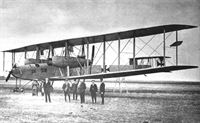 |
J.Herris - Zeppelin-Staaken Aircraft of WW1. Vol 1: VGO.1 - R.IV R.29/16 /Centennial Perspective/ (47)
|
| During flight testing the VGO.III was fitted with an auxiliary aileron balance on the rear outer interplane struts. These surfaces were designed to reduce aileron control forces to improve aileron response and reduce pilot fatigue. The surfaces were hinged aft of their center and connected to the ailerons. Similar methods of aileron balancing were tried by Gotha and Brandenburg seaplanes. However, the surfaces were removed from the VGO.III and not used on other Staaken aircraft. (Peter M. Grosz collection/STDB)
|
 |
J.Herris - Zeppelin-Staaken Aircraft of WW1. Vol 1: VGO.1 - R.IV R.29/16 /Centennial Perspective/ (47)
|
| The VGO.III being admired by a group of VIPs and guests. These views show the aircraft's details and massive size. (Peter M. Grosz collection/STDB)
|
 |
J.Herris - Zeppelin-Staaken Aircraft of WW1. Vol 1: VGO.1 - R.IV R.29/16 /Centennial Perspective/ (47)
|
| More views of the VGO.III R.10/15. It was a very large, impressive for the time. The overall configuration was conventionally similar to smaller biplanes. The aircraft's size and engine arrangement were the aspects that distinguished it from more common aircraft. (Peter M. Grosz collection/STDB)
|
 |
J.Herris - Zeppelin-Staaken Aircraft of WW1. Vol 1: VGO.1 - R.IV R.29/16 /Centennial Perspective/ (47)
|
| Powered by six engines, the Zeppelin-Staaken VGO III was the first of the strategic bombers' produced by this company. The aircraft saw operational service with RFa 500 on the Eastern Front in the early days of 1915; although its top speed was only 75mph (120kph) and its ceiling only 6,560ft (2,000m) it was defended by five machine guns.
|
 |
J.Herris - Zeppelin-Staaken Aircraft of WW1. Vol 1: VGO.1 - R.IV R.29/16 /Centennial Perspective/ (47)
|
| The VGO.III being admired by a group of VIPs and guests. These views show the aircraft's details and massive size. (Peter M. Grosz collection/STDB)
|
 |
J.Herris - Zeppelin-Staaken Aircraft of WW1. Vol 1: VGO.1 - R.IV R.29/16 /Centennial Perspective/ (47)
|
| During flight testing the VGO.III was fitted with an auxiliary aileron balance on the rear outer interplane struts. These surfaces were designed to reduce aileron control forces to improve aileron response and reduce pilot fatigue. The surfaces were hinged aft of their center and connected to the ailerons. Similar methods of aileron balancing were tried by Gotha and Brandenburg seaplanes. However, the surfaces were removed from the VGO.III and not used on other Staaken aircraft. (Peter M. Grosz collection/STDB)
|
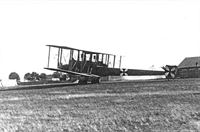 |
J.Herris - Zeppelin-Staaken Aircraft of WW1. Vol 1: VGO.1 - R.IV R.29/16 /Centennial Perspective/ (47)
|
| Side view of the VGO.III shows its basic configuration is essentially the same as the earlier VGO.I and VGO.II. (Peter M. Grosz collection/STDB)
|
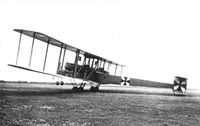 |
J.Herris - Zeppelin-Staaken Aircraft of WW1. Vol 1: VGO.1 - R.IV R.29/16 /Centennial Perspective/ (47)
|
| The VGO.III is here shown resting all its tailskid; the more normal attitude was for it to rest on its nose wheels with the tail high.
|
 |
J.Herris - Halberstadt Aircraft of WWI. Volume 2: CL.IV-CLS.I & Fighters /Centennial Perspective/ (45)
|
| Halberstadt D.I fitted with rockets for anti-balloon attacks under test at Doberitz. The aileron horn balances identify it as a D.I. The massive Staaken VGO.III is in the background. (Peter M. Grosz Collection/STDB)
|
 |
G.Haddow, P.Grosz - The German Giants /Putnam/
|
| VGO.III 10/15.
|
 |
J.Herris - Zeppelin-Staaken Aircraft of WW1. Vol 1: VGO.1 - R.IV R.29/16 /Centennial Perspective/ (47)
|
| More views of the VGO.III R.10/15. It was a very large, impressive for the time. The overall configuration was conventionally similar to smaller biplanes. The aircraft's size and engine arrangement were the aspects that distinguished it from more common aircraft. (Peter M. Grosz collection/STDB)
|
 |
J.Herris - Zeppelin-Staaken Aircraft of WW1. Vol 1: VGO.1 - R.IV R.29/16 /Centennial Perspective/ (47)
|
| More views of the VGO.III being admired by a group of VIPs and guests. These views show the aircraft's details and massive size. (Peter M. Grosz collection/STDB)
|
 |
J.Herris - Zeppelin-Staaken Aircraft of WW1. Vol 1: VGO.1 - R.IV R.29/16 /Centennial Perspective/ (47)
|
| The VGO.III, 8 September 1916 on delivery to Rfa 500.
|
 |
J.Herris - Zeppelin-Staaken Aircraft of WW1. Vol 1: VGO.1 - R.IV R.29/16 /Centennial Perspective/ (47)
|
The VGO.III on the tracks outside its hangar at Alt-Auz, summer 1916.
The VGO.III being admired by a group of VIPs. (Peter M. Grosz collection/STDB)
|
 |
J.Herris - Zeppelin-Staaken Aircraft of WW1. Vol 1: VGO.1 - R.IV R.29/16 /Centennial Perspective/ (47)
|
| This full front view of the VGO.III shows the six radiators for the six 160 hp Mercedes D.III engines. (Peter M. Grosz collection/STDB)
|
 |
J.Herris - Zeppelin-Staaken Aircraft of WW1. Vol 1: VGO.1 - R.IV R.29/16 /Centennial Perspective/ (47)
|
| This front view of the VGO.III shows the six radiators for the six 160 hp Mercedes D.III engines. This change in engines was to improve reliability by replacing the Maybach HS engines that caused so many problems. The radiators exhibit a great deal of flat-plate area, creating a lot of drag. The central fixed fin of the VGO.II was replaced by enlarged fins attached to the rudders. Other than these detail changes, the VGO.III closely resembled the earlier VGO aircraft. (Peter M. Grosz collection/STDB)
|
 |
J.Herris - Zeppelin-Staaken Aircraft of WW1. Vol 1: VGO.1 - R.IV R.29/16 /Centennial Perspective/ (47)
|
| The VGO.III being admired by a group of VIPs and guests. These views show the aircraft's details and massive size. (Peter M. Grosz collection/STDB)
|
 |
J.Herris - Zeppelin-Staaken Aircraft of WW1. Vol 1: VGO.1 - R.IV R.29/16 /Centennial Perspective/ (47)
|
|
|
 |
J.Herris - Zeppelin-Staaken Aircraft of WW1. Vol 1: VGO.1 - R.IV R.29/16 /Centennial Perspective/ (47)
|
| More views of the VGO.III being admired by a group of VIPs and guests. These views show the aircraft's details and massive size. (Peter M. Grosz collection/STDB)
|
 |
J.Herris - Zeppelin-Staaken Aircraft of WW1. Vol 1: VGO.1 - R.IV R.29/16 /Centennial Perspective/ (47)
|
| The VGO.III being admired by a group of VIPs and guests. These views show the aircraft's details and massive size. (Peter M. Grosz collection/STDB)
|
 |
J.Herris - Zeppelin-Staaken Aircraft of WW1. Vol 1: VGO.1 - R.IV R.29/16 /Centennial Perspective/ (47)
|
| The ventral gun position on a Staaken. From the VGO.II all Staaken bombers had this defensive gun mounting. The British Lewis aircraft machine gun as shown here was very popular in giant bomber crews. (Peter M. Grosz collection/STDB)
|
 |
J.Herris - Zeppelin-Staaken Aircraft of WW1. Vol 1: VGO.1 - R.IV R.29/16 /Centennial Perspective/ (47)
|
| The VGO.III R.10/15 takes off an another flight. (Peter M. Grosz collection/STDB)
|
 |
J.Herris - Zeppelin-Staaken Aircraft of WW1. Vol 1: VGO.1 - R.IV R.29/16 /Centennial Perspective/ (47)
|
| VGO.III 10/15 taking off from Gotha to fly to Doberitz, August 1916
|
 |
J.Herris - Zeppelin-Staaken Aircraft of WW1. Vol 1: VGO.1 - R.IV R.29/16 /Centennial Perspective/ (47)
|
| During flight testing the VGO.III was fitted with an auxiliary aileron balance on the rear outer interplane struts. These surfaces were designed to reduce aileron control forces to improve aileron response and reduce pilot fatigue. The surfaces were hinged aft of their center and connected to the ailerons. Similar methods of aileron balancing were tried by Gotha and Brandenburg seaplanes. However, the surfaces were removed from the VGO.III and not used on other Staaken aircraft. (Peter M. Grosz collection/STDB)
|
 |
J.Herris - Zeppelin-Staaken Aircraft of WW1. Vol 1: VGO.1 - R.IV R.29/16 /Centennial Perspective/ (47)
|
| The VGO.III R.10/15 after its landing gear collapsed on landing. (Peter M. Grosz collection/STDB)
|
 |
J.Herris - Zeppelin-Staaken Aircraft of WW1. Vol 1: VGO.1 - R.IV R.29/16 /Centennial Perspective/ (47)
|
| The charred remains of VGO.III after it crashed and burned on landing on January 24, 1917 at Alt-Aus on the Eastern Front. This was the first fatal accident in an R-plane. (Peter M. Grosz collection/STDB)
|
 |
J.Herris - Zeppelin-Staaken Aircraft of WW1. Vol 1: VGO.1 - R.IV R.29/16 /Centennial Perspective/ (47)
|
| The Staaken R.IV prior to the fitting of upper wing armament.
|
 |
J.Herris - Zeppelin-Staaken Aircraft of WW1. Vol 1: VGO.1 - R.IV R.29/16 /Centennial Perspective/ (47)
|
| Photo showing Staaken R.IV freshly delivered to Rfa 500 on the Eastern Front. After the fuel tanks were full the aircraft sat on its front wheels. At this point the R.IV did not have its upper wing guns. Note the small cooling openings at the front of the nacelles. (Peter M. Grosz collection/STDB)
|
 |
J.Herris - Zeppelin-Staaken Aircraft of WW1. Vol 1: VGO.1 - R.IV R.29/16 /Centennial Perspective/ (47)
|
| Staaken R.IV 12/15, here seen at Alt-Auz early in its long operational career.
|
 |
J.Herris - Zeppelin-Staaken Aircraft of WW1. Vol 1: VGO.1 - R.IV R.29/16 /Centennial Perspective/ (47)
|
| Photo showing Staaken R.IV freshly delivered to Rfa 500 on the Eastern Front. The personnel exercise in the massive aircraft's shadow. (Peter M. Grosz collection/STDB)
|
 |
J.Herris - Zeppelin-Staaken Aircraft of WW1. Vol 1: VGO.1 - R.IV R.29/16 /Centennial Perspective/ (47)
|
| Staaken R.VI R.25 at the left together with another Staaken, probably R.12, on the airfield. (Peter M. Grosz collection/STDB)
|
 |
J.Herris - Zeppelin-Staaken Aircraft of WW1. Vol 1: VGO.1 - R.IV R.29/16 /Centennial Perspective/ (47)
|
| The R.12 being admired by guests before camouflage was applied. (Peter M. Grosz collection/STDB)
|
 |
J.Herris - Zeppelin-Staaken Aircraft of WW1. Vol 1: VGO.1 - R.IV R.29/16 /Centennial Perspective/ (47)
|
| R.12 during service with Rfa 501 on the Western Front at Schweldewindeke airfield. R.12 previously served with Rfa on the Eastern Front, then was upgraded with wing gun positions, parachutes, and over-painted with night camouflage white outlined patee crosses in the normal positions. (Peter M. Grosz collection/STDB)
|
 |
J.Herris - Zeppelin-Staaken Aircraft of WW1. Vol 1: VGO.1 - R.IV R.29/16 /Centennial Perspective/ (47)
|
| Staaken R.IV R.12/15 was the single most successful R-plane; here its crew pre-flights it for another mission at Schweldewindeke airfield. R.12 wears night camouflage with white outlined patee crosses and light painted R.12/15 on fuselage side. R.12 is shown prior parachute mounting. (Peter M. Grosz collection/STDB)
|
 |
J.Herris - Zeppelin-Staaken Aircraft of WW1. Vol 1: VGO.1 - R.IV R.29/16 /Centennial Perspective/ (47)
|
|
|
 |
J.Herris - Zeppelin-Staaken Aircraft of WW1. Vol 1: VGO.1 - R.IV R.29/16 /Centennial Perspective/ (47)
|
| R.12 after parachutes were mounted; the parachute lines are visible on the fuselage side. The nacelle gunners and mechanics also appear to have parachutes in the fuselage. Tractor propellers prevented parachute use from the nacelles. Two big exhaust silencers direct the exhaust out of the engine. (Peter M. Grosz collection/STDB)
|
 |
J.Herris - Zeppelin-Staaken Aircraft of WW1. Vol 1: VGO.1 - R.IV R.29/16 /Centennial Perspective/ (47)
|
Staaken R.lV 12/15. The only R-plane to see action on both the Eastern and Western Fronts.
R.12 after parachute mounting and new camouflage. The antenna wire seen near bottom machine gun platform show that radio room was located just behind the bomb bay and main fuel tanks. Note the old patee crosses over-painted by black and new Balkenkreuze that were applied. (Peter M. Grosz collection/STDB)
|
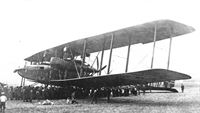 |
J.Herris - Zeppelin-Staaken Aircraft of WW1. Vol 1: VGO.1 - R.IV R.29/16 /Centennial Perspective/ (47)
|
| The Staaken R.IV was nearly identical in layout to the VGO.III, although the 160 hp Mercedes engines in the nacelles were replaced by more powerful 220 hp Benz Bz.IV engines. However, the aircraft looks different in this post-war photo due to its dark camouflage for night bombing at Western Front and the late-war style national insignia. (Peter M. Grosz collection/STDB)
|
 |
Jane's All The World Aircraft 1919 /Jane's/
|
| The Zeppelin Five-engined "Giant".
|
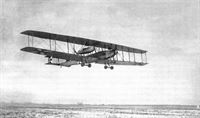 |
J.Herris - Zeppelin-Staaken Aircraft of WW1. Vol 1: VGO.1 - R.IV R.29/16 /Centennial Perspective/ (47)
|
| Staaken R.IV 12/15 during service with Rfa 500 on the Eastern Front. It is in its initial construction form without camouflage and with painted black patee crosses on white squares. (Peter M. Grosz collection/STDB)
|
 |
J.Herris - Zeppelin-Staaken Aircraft of WW1. Vol 2: R.VI R.30/16 - E.4/20 /Centennial Perspective/ (48)
|
| Staaken R.IV R.12/15 takes of on another mission.
|
 |
J.Herris - Zeppelin-Staaken Aircraft of WW1. Vol 1: VGO.1 - R.IV R.29/16 /Centennial Perspective/ (47)
|
| The R.12 in flight. (Peter M. Grosz collection/STDB)
|
 |
J.Herris - Zeppelin-Staaken Aircraft of WW1. Vol 1: VGO.1 - R.IV R.29/16 /Centennial Perspective/ (47)
|
| Another Staaken photographed from the Staaken R.IV in flight. (Peter M. Grosz collection/STDB)
|
 |
G.Haddow, P.Grosz - The German Giants /Putnam/
|
The engineers looking out of the forward eingine-room (engineer compartment) window of German five-engined "Giant" aeroplane Staaken R.IV.
Well-known photograph showing the flight engineers' station for the two front engines. Note two radiators mounted on top of the fuselage, just aft the tractor propeller. (Peter M. Grosz collection/STDB)
|
 |
J.Herris - Zeppelin-Staaken Aircraft of WW1. Vol 1: VGO.1 - R.IV R.29/16 /Centennial Perspective/ (47)
|
|
|
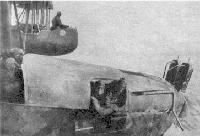 |
В.Обухович, А.Никифоров - Самолеты Первой Мировой войны
|
|
|
 |
J.Herris - Zeppelin-Staaken Aircraft of WW1. Vol 1: VGO.1 - R.IV R.29/16 /Centennial Perspective/ (47)
|
| In-flight views of R.12 taken from the starboard nacelle gun position. (Peter M. Grosz collection/STDB)
|
 |
J.Herris - Zeppelin-Staaken Aircraft of WW1. Vol 1: VGO.1 - R.IV R.29/16 /Centennial Perspective/ (47)
|
| In-flight view of the R.12 taken from the starboard nacelle gun position. (Peter M. Grosz collection/STDB)
|
 |
J.Herris - Zeppelin-Staaken Aircraft of WW1. Vol 1: VGO.1 - R.IV R.29/16 /Centennial Perspective/ (47)
|
|
|
 |
J.Herris - Zeppelin-Staaken Aircraft of WW1. Vol 1: VGO.1 - R.IV R.29/16 /Centennial Perspective/ (47)
|
| In-flight view of the R.12 taken from the starboard nacelle gun position. (Peter M. Grosz collection/STDB)
|
 |
J.Herris - Zeppelin-Staaken Aircraft of WW1. Vol 1: VGO.1 - R.IV R.29/16 /Centennial Perspective/ (47)
|
|
|
 |
J.Herris - Zeppelin-Staaken Aircraft of WW1. Vol 1: VGO.1 - R.IV R.29/16 /Centennial Perspective/ (47)
|
|
|
 |
J.Herris - Zeppelin-Staaken Aircraft of WW1. Vol 1: VGO.1 - R.IV R.29/16 /Centennial Perspective/ (47)
|
|
|
 |
J.Herris - Zeppelin-Staaken Aircraft of WW1. Vol 1: VGO.1 - R.IV R.29/16 /Centennial Perspective/ (47)
|
| In-flight views of R.12 taken from the starboard nacelle gun position. The photo shows the pilots and plane commander; the static line for a parachute is visible sewn to the fuselage side. (Peter M. Grosz collection/STDB)
|
 |
J.Herris - Zeppelin-Staaken Aircraft of WW1. Vol 1: VGO.1 - R.IV R.29/16 /Centennial Perspective/ (47)
|
|
|
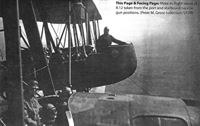 |
J.Herris - Zeppelin-Staaken Aircraft of WW1. Vol 1: VGO.1 - R.IV R.29/16 /Centennial Perspective/ (47)
|
| More in-flight views of R.12 taken from the port and starboard nacelle gun positions. (Peter M. Grosz collection/STDB)
|
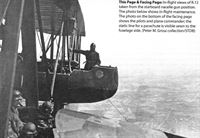 |
J.Herris - Zeppelin-Staaken Aircraft of WW1. Vol 1: VGO.1 - R.IV R.29/16 /Centennial Perspective/ (47)
|
| In-flight views of R.12 taken from the starboard nacelle gun position. (Peter M. Grosz collection/STDB)
|
 |
J.Herris - Zeppelin-Staaken Aircraft of WW1. Vol 1: VGO.1 - R.IV R.29/16 /Centennial Perspective/ (47)
|
| In-flight view of a gunner climbing up to the port over-wing gun position in the R.12. (Peter M. Grosz collection/STDB)
|
 |
J.Herris - Zeppelin-Staaken Aircraft of WW1. Vol 1: VGO.1 - R.IV R.29/16 /Centennial Perspective/ (47)
|
THE NOSE OF A GERMAN GIANT AEROPLANE. - Photograph taken from the port engine nacelle.
In-flight view of the R.12 taken from the starboard nacelle gun position. (Peter M. Grosz collection/ STDB)
|
 |
J.Herris - Zeppelin-Staaken Aircraft of WW1. Vol 1: VGO.1 - R.IV R.29/16 /Centennial Perspective/ (47)
|
| ON BOARD A GERMAN GIANT AEROPLANE. - Photograph showing view looking aft from the port engine nacelle.
|
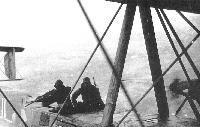 |
G.Haddow, P.Grosz - The German Giants /Putnam/
|
| Dorsal gunner's position on the Staaken R.IV.
|
 |
J.Herris - Zeppelin-Staaken Aircraft of WW1. Vol 1: VGO.1 - R.IV R.29/16 /Centennial Perspective/ (47)
|
| In-flight views of R.12 taken from the starboard nacelle gun position. The photos show the Parabellum M.14/17 machine guns mounted at the dorsal gun position. Note the shell bags on the guns and renovated lozenge camouflage at middle of the fuselage. (Peter M. Grosz collection/STDB)
|
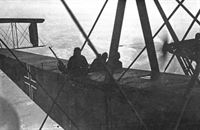 |
J.Herris - Zeppelin-Staaken Aircraft of WW1. Vol 1: VGO.1 - R.IV R.29/16 /Centennial Perspective/ (47)
|
| More in-flight views of R.12 taken from the starboard nacelle gun position. (Peter M. Grosz collection/STDB)
|
 |
J.Herris - Zeppelin-Staaken Aircraft of WW1. Vol 1: VGO.1 - R.IV R.29/16 /Centennial Perspective/ (47)
|
|
|
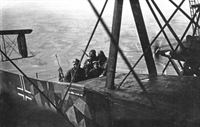 |
J.Herris - Zeppelin-Staaken Aircraft of WW1. Vol 1: VGO.1 - R.IV R.29/16 /Centennial Perspective/ (47)
|
|
|
 |
J.Herris - Zeppelin-Staaken Aircraft of WW1. Vol 1: VGO.1 - R.IV R.29/16 /Centennial Perspective/ (47)
|
|
|
 |
J.Herris - Zeppelin-Staaken Aircraft of WW1. Vol 1: VGO.1 - R.IV R.29/16 /Centennial Perspective/ (47)
|
ON BOARD A GERMAN GIANT AEROPLANE. - The mechanic is repairing an oil pump defect during flight. The photograph was taken from the port engine nacelle.
In-flight views of R.12 taken from the starboard nacelle gun position. The photo shows in-flight maintenance. (Peter M. Grosz collection/STDB)
|
 |
J.Herris - Zeppelin-Staaken Aircraft of WW1. Vol 1: VGO.1 - R.IV R.29/16 /Centennial Perspective/ (47)
|
| In-flight views of the R.12 taken from the starboard nacelle gun position. (Peter M. Grosz collection/STDB)
|
 |
J.Herris - Zeppelin-Staaken Aircraft of WW1. Vol 1: VGO.1 - R.IV R.29/16 /Centennial Perspective/ (47)
|
| More in-flight views of R.12 taken from the port and starboard nacelle gun positions. (Peter M. Grosz collection/STDB)
|
 |
J.Herris - Zeppelin-Staaken Aircraft of WW1. Vol 1: VGO.1 - R.IV R.29/16 /Centennial Perspective/ (47)
|
| The over-wing gun position on R.12 and the ladder to climb to it. (Peter M. Grosz collection/STDB)
|
 |
J.Herris - Zeppelin-Staaken Aircraft of WW1. Vol 1: VGO.1 - R.IV R.29/16 /Centennial Perspective/ (47)
|
| Right wing upper gun platform. (Peter M. Grosz collection/STDB)
|
 |
J.Herris - Zeppelin-Staaken Aircraft of WW1. Vol 1: VGO.1 - R.IV R.29/16 /Centennial Perspective/ (47)
|
A ZEPPELIN GIANT. - The photograph shows how the fuselage is entered through a door in the side.
Crewman pauses at the R.12 entry door. (Peter M. Grosz collection/STDB)
|
 |
J.Herris - Zeppelin-Staaken Aircraft of WW1. Vol 1: VGO.1 - R.IV R.29/16 /Centennial Perspective/ (47)
|
| The camouflaged Staaken R.IV in the hangar.The ventral gun position with British Lewis machine gun is clearly shown. (Peter M. Grosz collection/STDB)
|
 |
J.Herris - Zeppelin-Staaken Aircraft of WW1. Vol 1: VGO.1 - R.IV R.29/16 /Centennial Perspective/ (47)
|
| Staaken R.IV R.12/15 was the single most successful R-plane. In this postwar image the crew is photographed with the aircraft at Kassel; the targets, dates of the raids, and total weight of bombs are chalked on the fuselage.
|
 |
J.Herris - Zeppelin-Staaken Aircraft of WW1. Vol 1: VGO.1 - R.IV R.29/16 /Centennial Perspective/ (47)
|
The Staaken R.IV and its crew at Kassel after the war. The targets attacked, the total weight of bomb dropped and places flown to have been chalked on the fuselage side.
The Staaken R IV 12/15 had the longest operational career of any machine in the R category, and was the only one to be flown on both the Eastern and Western Fronts, from May 1917 until the Armistice. It survived a collision with a balloon cable over London in February 1918 and dropped a total of 25,000kg of bombs. It is seen at Kassel in April 1919 with its fuselage inscribed with the names of the main targets attacked (including London, Harwich, Chelmsford, Oesel Island (Baltic), Calais, Abbeville, Boulogne, Etaples, Doullens and Amiens) and the routeing of several long-distance flights occasioned by ferrying from one theatre of operations to another; eg, Gotha-Doeberitz-Koenigsberg-Riga.
|
 |
Jane's All The World Aircraft 1919 /Jane's/
|
| Three-quarter Front View of a Zeppelin Five-engined "Giant" bomber, probably one of the R.XIVs or XVs of 1918.
|
 |
G.Haddow, P.Grosz - The German Giants /Putnam/
|
| The Staaken R.lV on display to awed crowds in Kassel postwar, April 1919. (Peter M. Grosz collection/STDB)
|
 |
J.Herris - Zeppelin-Staaken Aircraft of WW1. Vol 1: VGO.1 - R.IV R.29/16 /Centennial Perspective/ (47)
|
| R.IV during assembly. At front or the picture not completed engines nacelle. Note the characteristic for Staaken nacelles, wooden bed for two engines coupled in one gearbox with light aluminium rib structure holding aluminum covers. Initial of radiators are visible, after first flights these were changed for better Hans Window type. (Peter M. Grosz collection/STDB)
|
 |
J.Herris - Zeppelin-Staaken Aircraft of WW1. Vol 2: R.VI R.30/16 - E.4/20 /Centennial Perspective/ (48)
|
| The Staaken R.VII on its factory airfield with admirers. (Peter M. Grosz collection/STDB)
|
 |
J.Herris - Zeppelin-Staaken Aircraft of WW1. Vol 1: VGO.1 - R.IV R.29/16 /Centennial Perspective/ (47)
|
| Staaken R.26/16 at right and R.VII R.14 on the left. (Peter M. Grosz collection/STDB)
|
 |
J.Herris - Zeppelin-Staaken Aircraft of WW1. Vol 2: R.VI R.30/16 - E.4/20 /Centennial Perspective/ (48)
|
| The Staaken R.VII R.14/15 reverted to the configuration of the R.IV and for practical purposes could have been considered an R.IV. However, whereas the R.IV was the most successful R-plane of the war, the R.VII was destroyed in a take-off accident while enroute to the front on August 16, 1917. (Peter M. Grosz collection/STDB)
|
 |
J.Herris - Zeppelin-Staaken Aircraft of WW1. Vol 2: R.VI R.30/16 - E.4/20 /Centennial Perspective/ (48)
|
| The Staaken R.VII on its factory airfield with admirers. (Peter M. Grosz collection/STDB)
|
 |
J.Herris - Zeppelin-Staaken Aircraft of WW1. Vol 2: R.VI R.30/16 - E.4/20 /Centennial Perspective/ (48)
|
| The Staaken R.VII on its field being viewed by VIPs. (Peter M. Grosz collection/STDB)
|
 |
J.Herris - Zeppelin-Staaken Aircraft of WW1. Vol 2: R.VI R.30/16 - E.4/20 /Centennial Perspective/ (48)
|
| The Staaken R.VII being viewed by a crowd of admirers. The nose engines drive a 2-bladed propeller. No camouflage has yet been applied. The radiators for the nacelle engines are separate with the forward radiator above the rear radiator. These unstreamlined radiators generated a lot of drag. (Peter M. Grosz collection/STDB)
|
 |
J.Herris - Zeppelin-Staaken Aircraft of WW1. Vol 2: R.VI R.30/16 - E.4/20 /Centennial Perspective/ (48)
|
| The Staaken R.VII (R.14/16) reverted to the configuration of the R.IV although some details were different. Here it is shown at the factory after completion. (Peter M. Grosz collection/STDB)
|
 |
J.Herris - Zeppelin-Staaken Aircraft of WW1. Vol 2: R.VI R.30/16 - E.4/20 /Centennial Perspective/ (48)
|
| The Staaken R.VII on its field. (Peter M. Grosz collection/STDB)
|
 |
J.Herris - Zeppelin-Staaken Aircraft of WW1. Vol 2: R.VI R.30/16 - E.4/20 /Centennial Perspective/ (48)
|
| The Staaken R.VII runs up its nose-mounted engines. (Peter M. Grosz collection/STDB)
|
 |
J.Herris - Zeppelin-Staaken Aircraft of WW1. Vol 2: R.VI R.30/16 - E.4/20 /Centennial Perspective/ (48)
|
| Front view of the Staaken R.VII. The people viewing the aircraft give scale to its huge size. (Peter M. Grosz collection/STDB)
|
 |
J.Herris - Zeppelin-Staaken Aircraft of WW1. Vol 2: R.VI R.30/16 - E.4/20 /Centennial Perspective/ (48)
|
| The Staaken R.VII on its field photographed from beyond the airfield fence. (Peter M. Grosz collection/STDB)
|
 |
J.Herris - Zeppelin-Staaken Aircraft of WW1. Vol 2: R.VI R.30/16 - E.4/20 /Centennial Perspective/ (48)
|
| The completed Staaken R.VII being admired by VIPs. The nose engines now drive a 4-bladed propeller. The aircraft is resting on its tail skid. The nose engine radiators are prominent and drag producing. (Peter M. Grosz collection/STDB)
|
 |
J.Herris - Zeppelin-Staaken Aircraft of WW1. Vol 2: R.VI R.30/16 - E.4/20 /Centennial Perspective/ (48)
|
| The Staaken R.VII runs up its engines. (Peter M. Grosz collection/STDB)
|
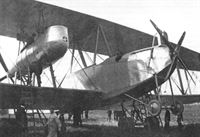 |
J.Herris - Zeppelin-Staaken Aircraft of WW1. Vol 2: R.VI R.30/16 - E.4/20 /Centennial Perspective/ (48)
|
| The Staaken R.VII with 4-bladed nose engines. The radiators are in out in the slip-stream for maximum cooling. (Peter M. Grosz collection/STDB)
|
 |
J.Herris - Zeppelin-Staaken Aircraft of WW1. Vol 2: R.VI R.30/16 - E.4/20 /Centennial Perspective/ (48)
|
| The Staaken R.VII (R.14/16) on its field. (Peter M. Grosz collection/STDB)
|
 |
J.Herris - Zeppelin-Staaken Aircraft of WW1. Vol 2: R.VI R.30/16 - E.4/20 /Centennial Perspective/ (48)
|
| The Staaken R.VII runs up its engines. (Peter M. Grosz collection/STDB)
|
 |
J.Herris - Zeppelin-Staaken Aircraft of WW1. Vol 2: R.VI R.30/16 - E.4/20 /Centennial Perspective/ (48)
|
| The completed Staaken R.VII being viewed by admirers. (Peter M. Grosz collection/STDB)
|
 |
J.Herris - Zeppelin-Staaken Aircraft of WW1. Vol 2: R.VI R.30/16 - E.4/20 /Centennial Perspective/ (48)
|
| The Staaken R.VII in close-up at the factory. (Peter M. Grosz collection/STDB)
|
 |
J.Herris - Zeppelin-Staaken Aircraft of WW1. Vol 2: R.VI R.30/16 - E.4/20 /Centennial Perspective/ (48)
|
| The Staaken R.VII in close-up at the factory. (Peter M. Grosz collection/STDB)
|
 |
J.Herris - Zeppelin-Staaken Aircraft of WW1. Vol 2: R.VI R.30/16 - E.4/20 /Centennial Perspective/ (48)
|
| The Staaken R.VII details. (Peter M. Grosz collection/STDB)
|
 |
J.Herris - Zeppelin-Staaken Aircraft of WW1. Vol 2: R.VI R.30/16 - E.4/20 /Centennial Perspective/ (48)
|
| The Staaken R.VII provides the background for a portrait of Staaken staff. (Peter M. Grosz collection/STDB)
|
 |
J.Herris - Zeppelin-Staaken Aircraft of WW1. Vol 2: R.VI R.30/16 - E.4/20 /Centennial Perspective/ (48)
|
| In flight photo of the Staaken R.VII taken from its starboard engine nacelle toward the tail. (Peter M. Grosz collection/STDB).
|
 |
J.Herris - Zeppelin-Staaken Aircraft of WW1. Vol 1: VGO.1 - R.IV R.29/16 /Centennial Perspective/ (47)
|
|
|
 |
J.Herris - Zeppelin-Staaken Aircraft of WW1. Vol 2: R.VI R.30/16 - E.4/20 /Centennial Perspective/ (48)
|
| Photo of the port engine nacelle of the Staaken R.VII taken from within the nacelle.The tail is in the left background. (Peter M. Grosz collection/ STDB)
|
 |
J.Herris - Zeppelin-Staaken Aircraft of WW1. Vol 1: VGO.1 - R.IV R.29/16 /Centennial Perspective/ (47)
|
| Engine nacelle of a Staaken bomber.
|
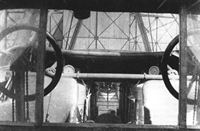 |
J.Herris - Zeppelin-Staaken Aircraft of WW1. Vol 2: R.VI R.30/16 - E.4/20 /Centennial Perspective/ (48)
|
| The Staaken R.VII details. (Peter M. Grosz collection/STDB)
|
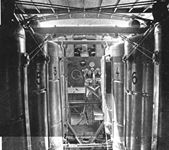 |
J.Herris - Zeppelin-Staaken Aircraft of WW1. Vol 2: R.VI R.30/16 - E.4/20 /Centennial Perspective/ (48)
|
| 245 liter fuel tanks installed in a Staaken R.VII bomber. Note that each fuel tank has a painted number; it was important for the flight engineer to correctly distribute fuel during the flight to maintain the center of gravity. (Peter M. Grosz collection/STDB)
|
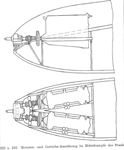 |
J.Herris - Zeppelin-Staaken Aircraft of WW1. Vol 1: VGO.1 - R.IV R.29/16 /Centennial Perspective/ (47)
|
| Drawing of the nose engines installed in the Staaken R.IV.
|
 |
J.Herris - Zeppelin-Staaken Aircraft of WW1. Vol 1: VGO.1 - R.IV R.29/16 /Centennial Perspective/ (47)
|
| Diagram of the fuel system of the Staaken R.IV.
|
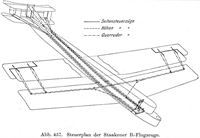 |
J.Herris - Zeppelin-Staaken Aircraft of WW1. Vol 1: VGO.1 - R.IV R.29/16 /Centennial Perspective/ (47)
|
| Diagram of the control system of the Staaken R.IV.
|
 |
J.Herris - Zeppelin-Staaken Aircraft of WW1. Vol 1: VGO.1 - R.IV R.29/16 /Centennial Perspective/ (47)
|
| Diagram of the control system details of the Staaken R.IV.
|
 |
J.Herris - Zeppelin-Staaken Aircraft of WW1. Vol 2: R.VI R.30/16 - E.4/20 /Centennial Perspective/ (48)
|
| Throttles and engine clutch for paired Staaken engines.
|
 |
J.Herris - Zeppelin-Staaken Aircraft of WW1. Vol 2: R.VI R.30/16 - E.4/20 /Centennial Perspective/ (48)
|
| Electro-pneumatic communication tube diagram for the Staaken R-planes.
|
 |
G.Haddow, P.Grosz - The German Giants /Putnam/
|
| V.G.O. III
|
 |
G.Haddow, P.Grosz - The German Giants /Putnam/
|
| Staaken R.IV
|
 |
G.Haddow, P.Grosz - The German Giants /Putnam/
|
| Staaken R.VII
|
 |
J.Herris - Zeppelin-Staaken Aircraft of WW1. Vol 2: R.VI R.30/16 - E.4/20 /Centennial Perspective/ (48)
|
| Staaken R.IV
|
 |
J.Herris - Zeppelin-Staaken Aircraft of WW1. Vol 2: R.VI R.30/16 - E.4/20 /Centennial Perspective/ (48)
|
| Staaken R.IV
|
 |
J.Herris - Zeppelin-Staaken Aircraft of WW1. Vol 2: R.VI R.30/16 - E.4/20 /Centennial Perspective/ (48)
|
| Staaken R.IV
|



























































































































